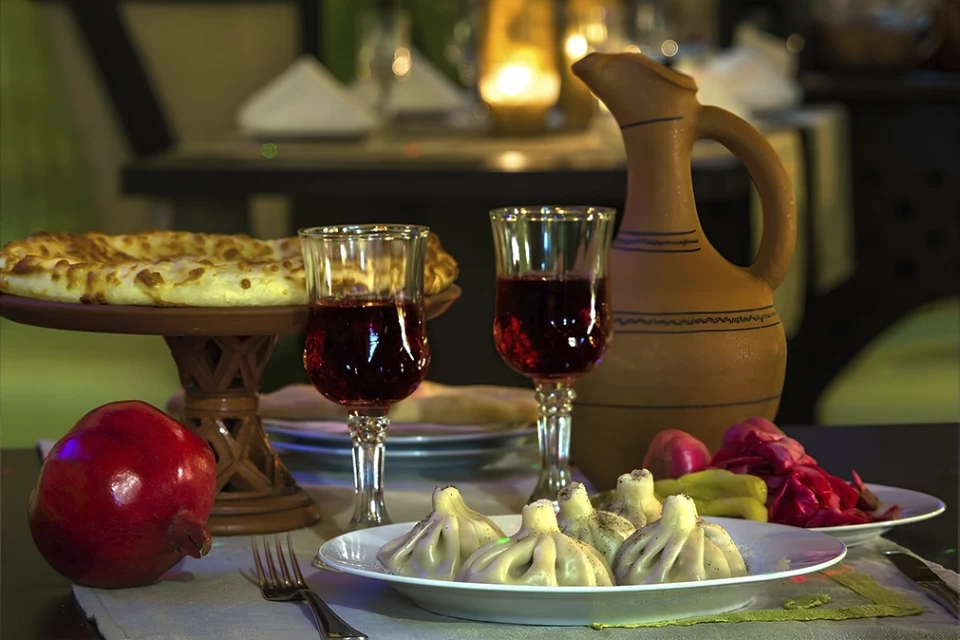When you think of Georgia, your mind may wander to breathtaking mountain landscapes, ancient churches, and warm hospitality. But to truly understand the soul of this beautiful country, you must experience its food. Georgian cuisine is a rich blend of bold flavors, fresh ingredients, and centuries-old traditions — a true feast for the senses.
Georgian cuisine is rich, diverse, and is deeply intertwined with the country’s history, geography, and traditions. It reflects a blend of influences from Europe, the Middle East, and Asia, which have shaped its unique culinary identity. It is known for its unique flavors, fresh ingredients, and a wide variety of dishes that include meats, vegetables, cheeses, and breads. Here’s a deeper look into Georgian food culture:
The Supra: Georgian Feast Tradition
The supra is a central element of Georgian food culture. It’s not just a meal but a ceremonial feast, often lasting several hours, where an array of dishes is served. The supra is characterized by:
- Abundance: A wide variety of dishes is served, often more than guests can consume, as a sign of generosity and hospitality.
- Tamada: The toastmaster who leads the event, guiding the sequence of toasts. Toasts are an essential part of the supra, often poetic and philosophical, celebrating life, love, friendship, and other values.
- Communal Sharing: Dishes are placed in the center of the table, encouraging sharing and interaction among guests.
Regional Variations and Specialties
Georgian cuisine varies significantly by region, each with its own specialties and culinary traditions:
- Kakheti: Known for its wine and meat dishes, such as mtsvadi (grilled skewers).
- Imereti: Famous for its cheese and khachapuri (cheese-filled bread).
- Samegrelo: Renowned for spicy and rich dishes like elarji (a cornmeal and cheese dish) and satsivi (chicken in walnut sauce).
- Adjara: Known for Adjarian khachapuri and seafood dishes, reflecting its Black Sea coastline.
Influence of Geography and Agriculture
Georgia’s diverse climate and fertile soil allow for a wide range of agricultural products, influencing its cuisine:
- Fruits and Vegetables: Fresh produce like tomatoes, eggplants, cucumbers, and pomegranates are staples.
- Nuts and Seeds: Walnuts, hazelnuts, and sunflower seeds are commonly used, especially in sauces and salads.
- Grapes and Wine: With over 8,000 years of winemaking history, Georgia boasts a rich wine culture. Traditional winemaking methods, such as fermenting wine in qvevri (large clay vessels buried underground), are still practiced.
Traditional Cooking Methods
- Tone Oven: A traditional clay oven used for baking bread, giving it a distinct texture and flavor.
- Clay Pots: Often used for slow-cooking stews and soups, enhancing the depth of flavors.
- Grilling and Smoking: Meat dishes like kebabs and sausages are often grilled or smoked, imparting a distinctive taste.
Festive Foods and Religious Influence
Georgia’s religious calendar, particularly the Orthodox Christian tradition, significantly influences its cuisine:
- Fasting Periods: During these times, meat and animal products are avoided, leading to the creation of a variety of vegetarian and vegan dishes, such as pkhali (vegetable and walnut paste) and lobio (bean stew).
- Holiday Foods: Special dishes are prepared for religious and national holidays, like churchkhela (a traditional sweet made of grape must, nuts, and flour) and Easter bread.
Contemporary Trends and Revival
- Fusion and Innovation: Modern Georgian cuisine sees a blend of traditional dishes with contemporary techniques and international influences, creating new and innovative dishes.
- Revival of Traditional Recipes: There’s a growing movement to preserve and revive traditional Georgian recipes, including ancient winemaking techniques and regional specialties.
If you ever find yourself in Georgia, come hungry and curious. Whether you’re in a cozy Tbilisi restaurant, a rustic village home, or wandering through a local market, Georgian cuisine promises an unforgettable journey of flavors and warmth.
5 main reasons why Georgia is worth traveling to Georgia stands out from other countries with its unique nature, historical heritage, language and cultural diversity. It is a country that captivates visitors with its beautiful landscapes, ancient culture and warm-hearted people. Exceptional nature From the Caucasus Mountains to the Black Sea climate, Georgia offers stunning… Continue reading 5 main reasons why Georgia is worth traveling to
Georgian culture Georgian culture is rich and diverse, deeply rooted in the history and traditions of the Georgian people. Situated at the crossroads of Europe and Asia, Georgia has been influenced by various civilizations and empires, which is reflected in its cultural heritage. Georgian culture is an exotic, mysterious and ancient culture stretching back for… Continue reading Georgian Culture
The History of Georgian Wine Ancient Origins Georgia is often referred to as the “cradle of wine,” with a winemaking tradition that dates back over 8,000 years. Archaeological evidence, including ancient grape pips and winemaking artifacts, suggests that the cultivation of grapes and production of wine began in the region around 6000-5800 BCE. The… Continue reading Georgian Wine
When you think of Georgia, your mind may wander to breathtaking mountain landscapes, ancient churches, and warm hospitality. But to truly understand the soul of this beautiful country, you must experience its food. Georgian cuisine is a rich blend of bold flavors, fresh ingredients, and centuries-old traditions — a true feast for the senses. Georgian… Continue reading Georgian Cuisine
Georgia, nestled at the crossroads of Europe and Asia, offers a diverse array of resorts that cater to every traveler’s desires—from serene mountain retreats and rejuvenating spa towns to sun-kissed Black Sea beaches and historic wine regions. Here’s a curated guide to some of the country’s most captivating resort destinations. Everyone likes to vacay at… Continue reading Resorts of Georgia







